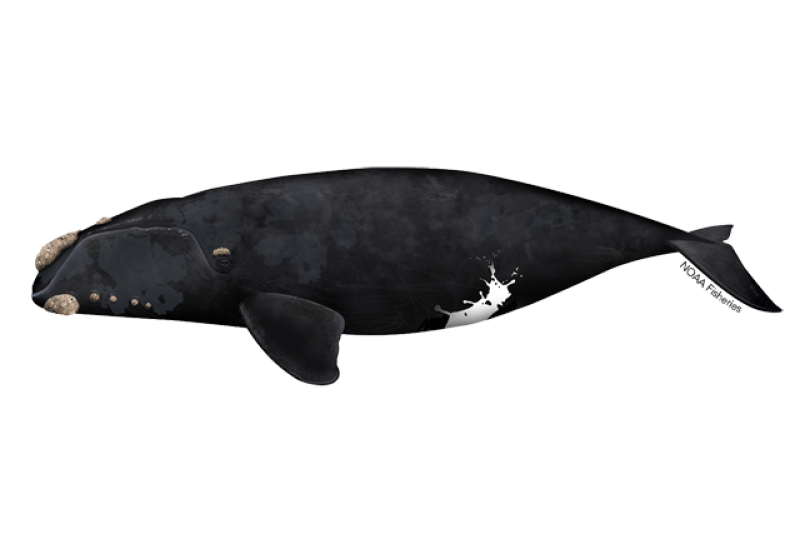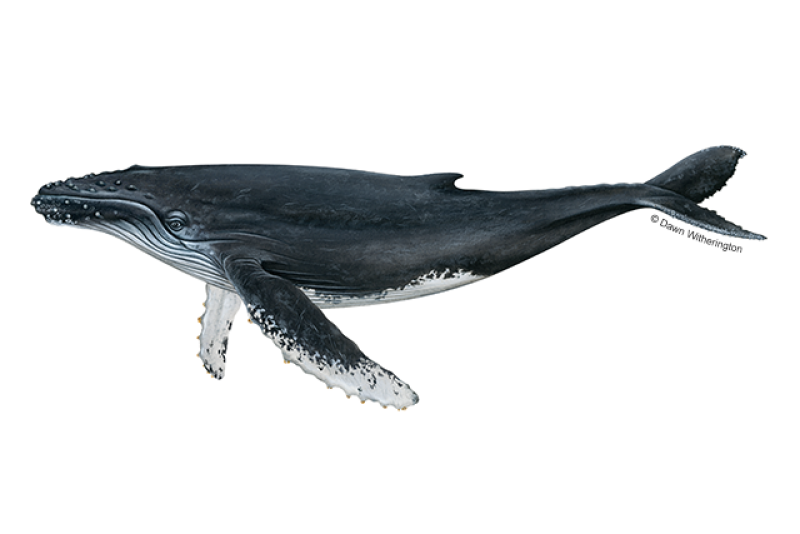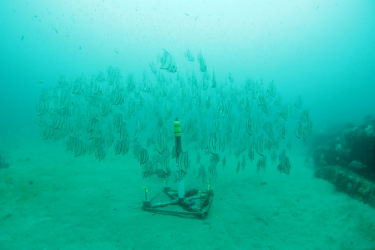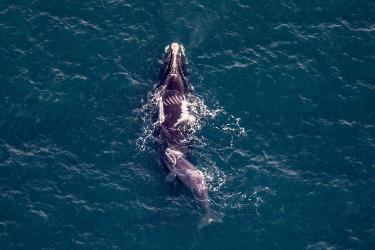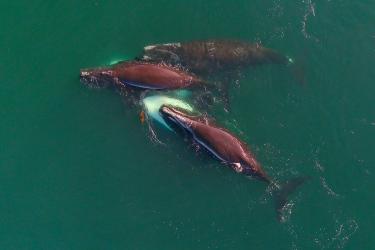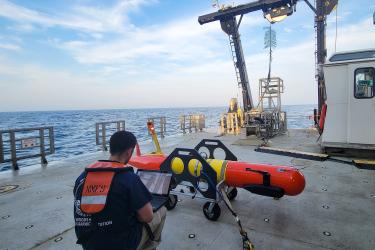North Atlantic Right Whale
North Atlantic Right Whale
Eubalaena glacialis

Protected Status
Quick Facts
 A right whale breaches. Credit: NOAA Fisheries
A right whale breaches. Credit: NOAA Fisheries
A right whale breaches. Credit: NOAA Fisheries
What's New
About the Species
 A right whale breaches. Credit: NOAA Fisheries
A right whale breaches. Credit: NOAA Fisheries
A right whale breaches. Credit: NOAA Fisheries
The North Atlantic right whale is one of the world’s most endangered large whale species.
Two other species of right whales exist: the North Pacific right whale, which is found in the North Pacific Ocean, and the Southern right whale, which is found in the southern hemisphere. Right whales are baleen whales, feeding on copepods (tiny crustaceans) by straining huge volumes of ocean water through their baleen plates, which act like a sieve.
By the early 1890s, commercial whalers had hunted North Atlantic right whales to the brink of extinction. (They got their name from being the "right" whales to hunt because they floated when they were killed.) Whaling is no longer a threat, but they have never recovered to pre-whaling numbers, and human interactions still present the greatest danger to this species. Entanglement in fishing gear and vessel strikes are the leading causes of North Atlantic right whale mortality. Increasing ocean noise levels from human activities are also a concern since the noise may interfere with right whale communication and increase their stress levels.
NOAA Fisheries and our partners are dedicated to conserving and rebuilding the North Atlantic right whale population. We use a variety of innovative techniques to study, protect, and recover these endangered whales. We engage our partners, including the fishing and shipping industries, as we develop regulations and management plans that foster healthy fisheries and reduce the risk of entanglements, slow down vessel traffic, and reduce ocean noise.
Read the North Atlantic Right Whale Scenario Planning Summary Report
Population Status
North Atlantic right whales have been listed as endangered under the Endangered Species Act since 1970. There are approximately 370 individuals remaining, including about 70 reproductively active females. Human impacts continue to threaten the survival of this species. The number of new calves born in recent years has been below average.
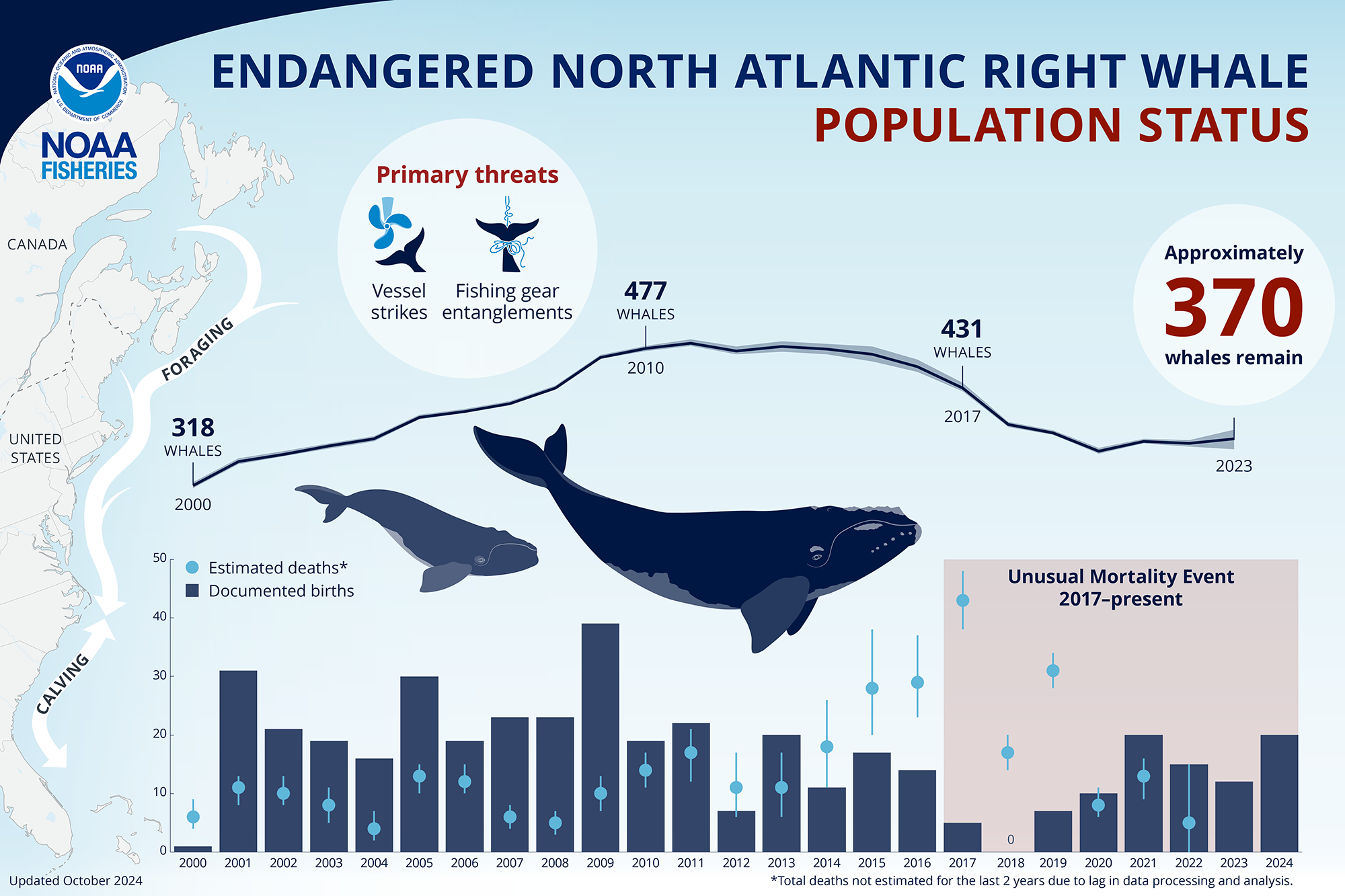
They have experienced an ongoing Unusual Mortality Event since 2017, which includes sublethally injured or ill, seriously injured, and dead right whales. The whales impacted by the UME represent more than 20 percent of the population, which is a significant impact on an endangered species where deaths are outpacing births. Additionally, research demonstrates that only about 1/3 of right whale deaths are documented.

Appearance
North Atlantic right whales have stocky black bodies with no dorsal fins, and their blow spouts are shaped like a “V.” Their tails are broad, deeply notched, and all black with a smooth trailing edge. Their bellies may be all black or have irregularly shaped white patches. Pectoral flippers are relatively short, broad, and paddle-shaped. Calves are about 14 feet at birth and adults can grow to lengths of 52 feet.
Their heads have knobby white patches of rough skin, called callosities, which appear white because of whale lice (cyamids) covering their otherwise black skin. Each right whale has a unique pattern of callosities that scientists use to identify individual whales, an invaluable tool in tracking population size and health. Aerial and ship-based surveys and the North Atlantic Right Whale Consortium’s photo-identification database maintained by our partners at the New England Aquarium help track individuals over the years.
Behavior and Diet
When viewing right whales, you might see these enormous creatures breaching and then crashing back down with a thunderous splash. You might also see them swimming along with their rostrum out of the water as they skim feed on dense patches of plankton. Right whales feed by opening their mouths while swimming slowly through large patches of copepods and other zooplankton. They filter out these tiny organisms from the water through their baleen, where the copepods become trapped in a tangle of hair-like material that acts like a sieve. Right whales feed anywhere from the water’s surface to the bottom of the water column.
Groups of right whales may be seen actively socializing at the water’s surface, known as surface-active groups, or SAGs. Mating and socializing occurs in SAGs, which are observed during all seasons and in all habitats.
Right whales communicate using low-frequency moans, groans, and pulses, which may maintain contact between individuals, communicate threats, signal aggression, or be used for other social reasons.
Where They Live
North Atlantic right whales primarily occur in Atlantic coastal waters on the continental shelf, although they also are known to travel far offshore, over deep water.
Right whales migrate seasonally and may travel alone or in small groups. In the spring, summer, and into fall, many of these whales can be found in waters off New England and further north into Canadian waters, where they feed and mate.
Each fall, some right whales travel more than 1,000 miles from these feeding grounds to the shallow, coastal waters of their calving grounds off of South Carolina, Georgia, and northeastern Florida, though migration patterns vary.
NOAA Fisheries has designated two areas as critical habitat for North Atlantic right whales. These areas provide important feeding, nursery, and calving habitat:
- Off the coast of New England (foraging area)
- Off the southeast U.S. coast from Cape Fear, North Carolina, to below Cape Canaveral, Florida (calving area)
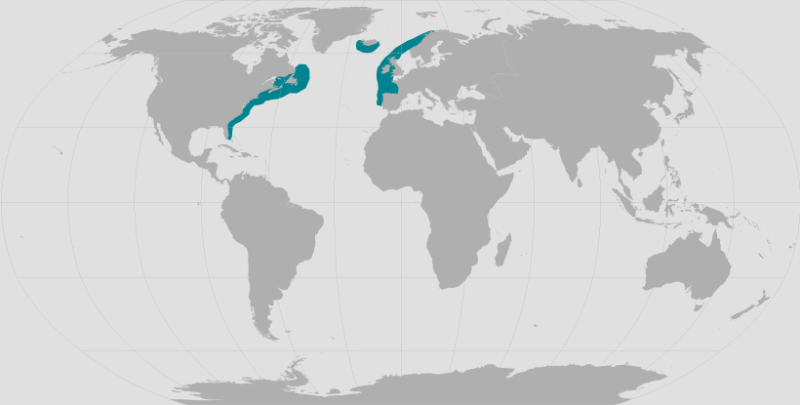 World map providing approximate representation of the North Atlantic right whale's range.
World map providing approximate representation of the North Atlantic right whale's range.
Lifespan & Reproduction
Right whales can probably live for at least 70 years, but data on their average lifespan is limited since scientific monitoring of the species is fairly recent. Ear wax can be used to estimate age in right whales after they have died. Another way to determine lifespan is to look at groups of closely related species. There are indications that some species closely related to right whales may live more than 100 years. However, female North Atlantic right whales are now only living to around 45 years old and males only to around 65 years old. Such reduced lifespans are due to human-caused mortality, not old age.
In recent years, researchers have recorded more deaths among adult females than adult males, leading to a population with more males than females, a bias that is increasing over time. Females that undergo energetic stress from reproduction may be more susceptible than males to dying from chronic injuries such as those from entanglement or vessel strikes.
Female right whales become sexually mature at about age 10. They give birth to a single calf after a year-long pregnancy. Three years is considered a normal or healthy interval between right whale births. But now, on average, females are having calves every 6 to 10 years. Biologists believe that the additional stress caused by entanglement is one of the reasons that females are calving less often.
Threats
North Atlantic right whales face many threats, including entanglement in fishing gear, vessel strikes, climate change—which may alter their migratory patterns and feeding areas—and the impacts of ocean noise on their ability to communicate, find food, and navigate.
Entanglements

Entanglement in fishing gear is one of the greatest threats to North Atlantic right whales. NOAA Fisheries and our partners estimate that over 85 percent of right whales have been entangled in fishing gear at least once. Fishing gear can cut into a whale’s body, cause serious injuries, and result in infections and mortality. Even if gear is shed or removed through disentanglement efforts, the time spent entangled can severely stress a whale, weaken it, prevent it from feeding, and sap the energy it needs to swim, feed, and reproduce. Chronic entanglements are one reason scientists think that female right whales are having fewer calves and are taking longer to have calves.
Vessel Strikes
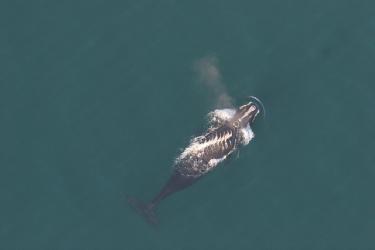
Vessel strikes are another major threat to right whales. Their habitat and migration routes are close to major ports along the Atlantic coastline and often overlap with shipping lanes, making right whales vulnerable to collisions with vessels. These collisions can cause broken bones and massive internal injuries or cuts from propellers. Vessels of nearly any size can injure or kill a right whale. The faster a vessel is traveling when it hits a whale, the higher the likelihood of serious injury or death.
Climate Change
The changing climate, and more specifically oceanographic changes in the Northwest Atlantic, are key factors contributing to reduced reproduction and higher susceptibility to human-caused threats. Over the past decade, right whales have changed their distribution patterns, likely in response to changes in prey location and availability due to warming oceans. As their prey moved, the whales began spending more time in areas with fewer protections from vessel strikes and entanglements.
A dip in right whale births and lengthened calving intervals (from 3 to 5 years to 6 to 10 years) indicates that reproductively active females have struggled in recent years to find sufficient food resources to support pregnancy. As their environment changes, right whales will likely continue to modify their distribution and behavior to adapt, resulting in a more uncertain and unpredictable future for the species.
Ocean Noise
Ocean noise from human activities such as shipping, boating, construction, and energy exploration and development has increased in the Northwest Atlantic. Noise from these activities can interrupt the normal behavior of right whales and interfere with their communication. It may also reduce their ability to detect and avoid predators and human hazards, navigate, identify physical surroundings, find food, and find mates.
Scientific Classification
| Kingdom | Animalia | Phylum | Chordata | Class | Mammalia | Order | Cetacea | Family | Balaenidae | Genus | Eubalaena | Species | glacialis |
|---|
Last updated by NOAA Fisheries on 09/30/2025
What We Do
Conservation & Management
We are committed to the protection and recovery of the North Atlantic right whale through implementation of various conservation, regulatory, rescue, and enforcement measures. Our work includes:
- Protecting habitat and designating critical habitat
- Rescuing entangled right whales
- Reducing the threat of vessel collisions
- Reducing injury and mortality by fishing gear
- Minimizing the effects of vessel disturbance and noise
Science
We conduct various research activities on the biology, behavior, and ecology of the North Atlantic right whale. The results of this research are used to inform management decisions and enhance recovery efforts for this endangered species that is headed toward extinction. Our work includes:
- Identifying habitat and when it is used by right whales
- Investigating unusual mortality events
- Performing stock assessments to gather population information
- Tracking individuals over time to monitor important population traits
How You Can Help
Report a Right Whale Sighting
Please report all right whale sightings from Virginia to Maine at (866) 755-6622 and from Florida to North Carolina at 877-WHALE-HELP ((877) 942-5343). Right whale sightings in any location may also be reported to the U.S. Coast Guard via channel 16 or through the Whale Alert app.
Include the date, time of day, location (e.g., latitude and longitude, or proximity to a landmark), contact information, and any other details or documentation about the observation including the number of whales, a description of what you saw (shape of the tail, flippers, or head). Photos and videos are particularly helpful.
Stay 500 Yards Away
To protect right whales, NOAA Fisheries has regulations that prohibit approaching or remaining within 500 yards (1,500 feet) of a right whale—500 yards is the length of about five football fields. These regulations apply to vessels and aircrafts (including drones) and to people using other watercrafts, such as surfboards, kayaks, and jet skis. Any vessel within 500 yards of a right whale must depart immediately at a safe, slow speed.
Call the NOAA Fisheries Enforcement Hotline at (800) 853-1964 to report a federal marine resource violation. This hotline is available 24 hours a day, 7 days a week for anyone in the United States.
Learn more about our marine life viewing guidelines
Report Marine Life in Distress
Report a sick, injured, entangled, stranded, or dead animal to make sure professional responders and scientists know about it and can take appropriate action. Numerous organizations around the country are trained and ready to respond. Never approach or try to save an injured or entangled animal yourself—it can be dangerous to both the animal and you.
Learn who you should contact when you encounter a stranded or injured marine animal
Be Informed and Get Involved
Stay updated on right whale take reduction and other conservation measures. For accurate information, check your sources or confirm them by reviewing our news and announcements. Participate in public meetings and share your perspectives with Take Reduction Team members who represent your constituency.
Featured News
 Credit: NOAA/Maria Harvey
Credit: NOAA/Maria Harvey
NOAA Announces Confirmed U.S. Large Whale Entanglement Numbers for 2024
Where the Copepods Are: Prey Data Can Improve Right Whale Models
 Southern resident killer whales. Credit: NOAA Fisheries/Candice Emmons
Southern resident killer whales. Credit: NOAA Fisheries/Candice Emmons
Workshop Targets High-Tech Ways to Assess Endangered Whale Health
NOAA Announces Confirmed Large Whale Entanglement Numbers for 2023
Road to Recovery
Endangered North Atlantic right whales remain highly vulnerable to extinction, as human impacts continue to threaten the survival of the species. There are approximately 370 individuals remaining, including about 70 reproductively active females. The species has experienced an ongoing Unusual Mortality Event since 2017. The whales impacted by the UME include dead, injured, and sick individuals.
Primary threats to the species—and drivers of the UME—are entanglement in fishing gear and vessel strikes. Changing ocean conditions are also affecting every aspect of their survival, including their habitat, their migratory patterns, the location and availability of their prey, and even their risk of becoming entangled in fishing gear or struck by vessels.
The North Atlantic Right Whale Road to Recovery describes NOAA Fisheries’ efforts to address threats to the species and monitor recovery progress. It is built on the foundation of the statutory requirements that we are charged with implementing under the Endangered Species Act and the Marine Mammal Protection Act. It shows how our collective actions, in collaboration with partners, fit together to save this iconic species. The strategy complements the North Atlantic right whale 2021–2025 Priority Action Plan by identifying our goals and related objectives, and by tracking and communicating progress on major activities and associated milestones, examples of which are given below.
The Road to Recovery is a dynamic resource and will be updated regularly. The “Recent Activities and Milestones” below were last updated on July 11, 2025.
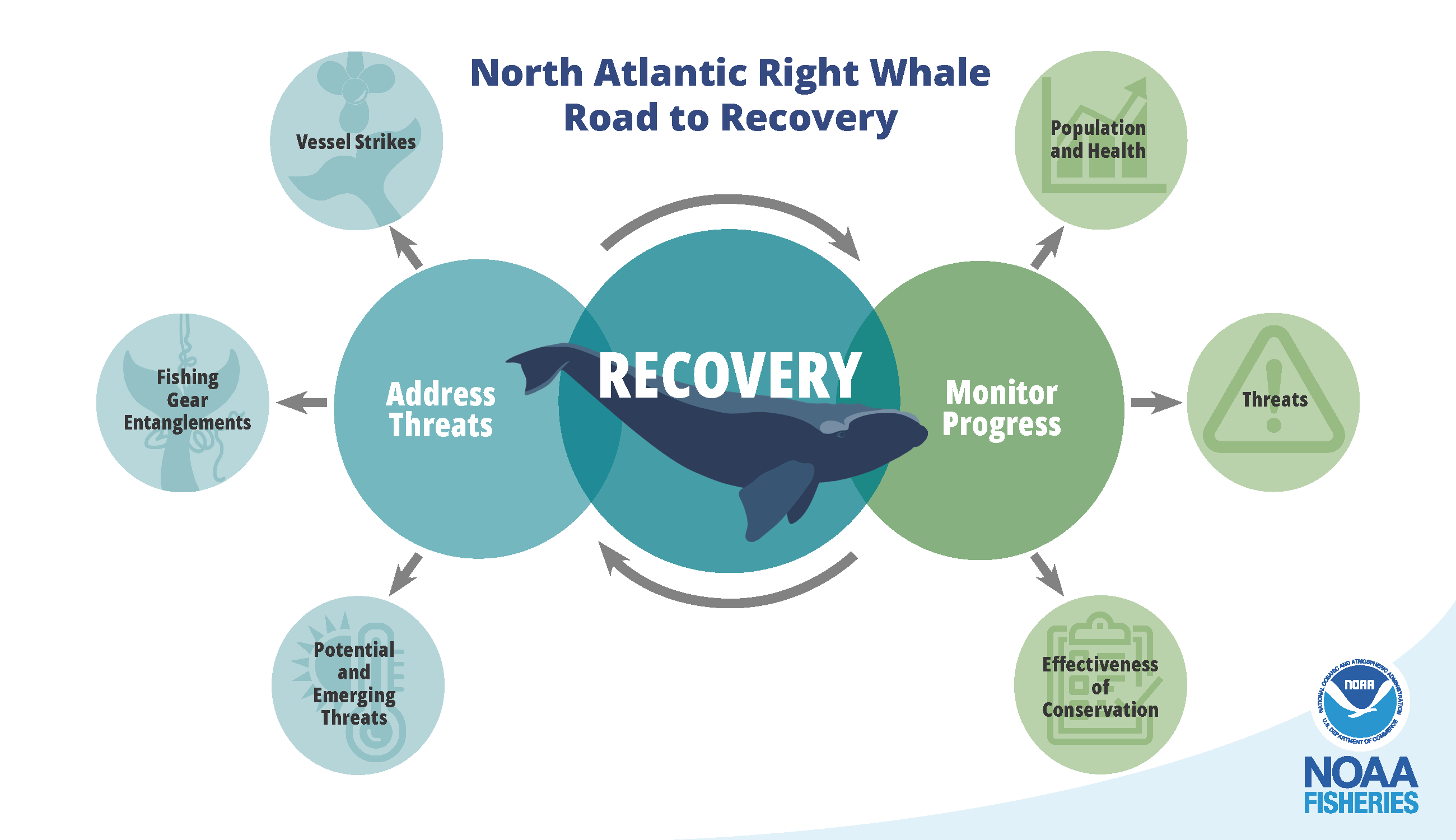
The efforts that pave the way on the Road to Recovery are only possible with the support and collaboration of many partners, such as the Marine Mammal Commission and Canada (see the 2021–2025 Priority Action Plan and Recovery Plan).
In October 2024, NOAA Fisheries released the North Atlantic right whale population viability analysis tool. It was developed through a 5-year collaboration with partners from the United States and Canada. This tool helps users understand how the population will change over 100 years if threats are mitigated. The results demonstrate that vessel strikes and entanglements must be reduced considerably for the species to persist.
The population viability analysis tool will help guide our Road to Recovery, as it allows us to evaluate the scope of conservation activities needed. It also shows how successful our actions may be at recovering endangered North Atlantic right whales.
To reduce the risks identified in our Road to Recovery, we are making critical investments in monitoring, enforcement, and investigation of new technologies and innovative solutions.
Goal: Address Threats to the Species
For endangered North Atlantic right whales to recover, we must address existing and emerging threats to the species. To achieve this goal, the Road to Recovery focuses on three objectives:
- Address vessel strikes
- Address fishing gear entanglements
- Address potential and emerging threats
Vessel Strikes

North Atlantic right whales are sometimes referred to as the "urban whale" due to their proximity to populated, coastal environments. This proximity leads to strikes from vessels moving through these waters, resulting in injury or death. Reducing vessel strikes is necessary to mitigate extinction risk. Since 2017, when the Unusual Mortality Event began, at least 18 right whales have been confirmed dead or observed seriously injured due to vessel strike. Many vessel strike injuries go undetected, as visual observations of live whales do not account for possibility of internal blunt force trauma injuries.
Recent Activities and Milestones
- Publishing two updated vessel strike risk-related models (Garrison et al. 2025 and Blondin et al. 2025), which characterize the probability that a vessel strike will cause death or serious injury for large whales based on vessel speed and size
- Holding a public workshop in March 2024, focused on developing new and emerging technologies to support vessel strike reduction
- Working with partners to launch an Automatic Identification System-based communication network for vessels traveling within Seasonal Management Areas
- Partnering with MITRE to focus on the development of technologies related to whale detection and vessel strike avoidance
- Working with the National Fish and Wildlife Foundation to support development of technologies to minimize risk from vessel strikes through the Vessel Strike Avoidance Fund
- Conducting public outreach and engagement to raise awareness on vessel strike risk, such as the annual calving season campaign, through web stories, videos, and social media posts
Fishing Gear Entanglements

North Atlantic right whales breed, feed, and move through areas of high fishing activity along the East Coast of North America. This leads to incidental entanglements in fishing gear, a primary cause of right whale mortality and serious injury. Reducing entanglements is necessary to mitigate extinction risk given that more than 85 percent of the population has been entangled at some point in their lifetime. Since 2017, when the Unusual Mortality Event began, at least 45 right whales have been confirmed dead or observed seriously injured due to entanglement, with estimates suggesting the true number is likely closer to 100 due to unobserved deaths.
Recent Activities and Milestones
- Issuing a final rule in February 2024 to amend the Atlantic Large Whale Take Reduction Plan to expand the boundaries of the Massachusetts Restricted Area to include the wedge between state and federal waters
- Planning for Atlantic Large Whale Take Reduction Team meetings in late 2025 and early 2026 for the Team to develop entanglement risk reduction recommendations to NOAA Fisheries, in order to have a final rule in place by December 31, 2028, as directed by Congress in the Consolidated Appropriations Act of 2023
- Presenting summer webinar series to prepare Team members for upcoming deliberative meetings
- Collaborating with fishermen and fishing gear manufacturers along the Atlantic coast to develop and test innovative fishing gear, such as on-demand gear, which provides fishermen with options to access areas closed to fishing with persistent vertical buoy lines to reduce the risk of entanglements. Progress includes:
- Working with the National Fish and Wildlife Foundation on a grant program to support development of innovative fishing gear through the New England Gear Innovation Fund, which uses the supplemental funding appropriated to NOAA Fisheries in the Consolidated Appropriations Act of 2023
- Expanding the issuance of exempted fishing permits to allow fishermen to test on-demand gear in restricted waters in the Northeast and Southeast United States
- Publishing the On-Demand Gear Guide that outlines next steps toward providing fishermen options to use on-demand gear systems as an alternative to fishing with surface marking systems, as well as A Proposal for Functional Data Specifications of On-Demand Fishing Gear (PDF, 13 pages) based on multiple workshops with stakeholders, including fishermen, state resource managers, and enforcement officers, to gather public input on operationalizing on-demand gear
Potential and Emerging Threats

As human activities and environments change, right whales may face additional potential and emerging threats. These threats include impacts from climate change, new and expanded ocean uses, and ocean noise. Assessing and mitigating threats are necessary to mitigate extinction risk.
Recent Activities and Milestones
- Finalizing the joint Bureau of Ocean Energy Management and NOAA Fisheries strategy, which includes recommendations to evaluate and mitigate the potential effects of offshore wind energy development on North Atlantic right whales and their habitat
- Issuing Marine Mammal Protection Act Incidental Take Authorizations and final Endangered Species Act Section 7 biological opinions for multiple offshore energy projects, which require specific measures to avoid and minimize impacts to right whales and to monitor and report on the impacts
Goal: Monitor Recovery Progress
Monitoring is crucial to track the status of right whales and evaluate the effectiveness of our efforts to address threats. To achieve this goal, the Road to Recovery focuses on three objectives:
- Monitor population and health
- Monitor threats
- Monitor effectiveness of conservation
Monitor Population and Health
Long-term monitoring of the population and health is critical for tracking the status of North Atlantic right whales over time. It provides an understanding of individual health and reproduction as well as distribution, abundance, and habitat-use patterns of the population.
Recent Activities and Milestones
- Generating the annual North Atlantic right whale population estimate in collaboration with the New England Aquarium and publishing a technical memorandum describing the underlying analysis
- Increasing the number of passive acoustic monitoring archival units between North Carolina and Florida to 32 to monitor right whales during calving season
- Initiating five ongoing monthly redeployment cycles of 50 passive acoustic monitoring units between Virginia and the Gulf of Maine in January 2025
- Co-hosting a North Atlantic right whale tagging workshop with the Maine Mammal Commission and the U.S. Navy in coordination with Fisheries and Oceans Canada in September 2023. The workshop and its report (PDF, 37 pages) reviewed the best available science to inform future planning and permitting decisions regarding the use of satellite telemetry tagging for right whales.
- Supporting annual aerial and vessel surveys in important whale habitats, like Cape Cod Bay and the Southeast calving grounds, to mitigate human activities and collect critical monitoring data
- Publishing the final 2023 North Atlantic right whale Stock Assessment Report (PDF, 23 pages)
- Investigating innovative technological solutions to address some of the greatest threats to North Atlantic right whales under the Advanced Sampling and Technology for Extinction Risk Reduction and Recovery program, including cutting-edge vessel strike risk reduction technologies, satellite telemetry tagging, very high resolution satellite imagery, and enhanced modeling efforts
Monitor Threats
With changing ocean conditions and human activities, it is crucial to continually monitor threats to the species.
Recent Activities and Milestones
- Continuing to respond to and investigate the North Atlantic right whale Unusual Mortality Event, and reviewing previous cases of injury and illness to evaluate the health status of individuals based on our morbidity protocol for the UME
- Completing necropsies on recently stranded right whales (#5120 in February 2024, a juvenile female in February 2024, a calf in March 2024, and #1950 in April 2024)
- Continuing work of the internal North Atlantic Right Whale Health Assessment Implementation Working Group to build an integrated health assessment program identifying priority questions and samples for analysis
- Hosting a 2024 Species in the Spotlight Health Assessment Workshop, which included right whales and other whale species, with a focus more efficient development of new health assessment tools through cross-species collaborations
- Authorizing the marine mammal stranding and entanglement response networks and working with them through the Marine Mammal Health and Stranding Response Program and its Prescott Grant Program, National Stranding Database, and stranding reports
- Tracking ocean warming and changes in marine development activities, commercial fishing operations, and vessel traffic
Monitor Effectiveness of Conservation
To ensure our conservation efforts are effective, we regularly evaluate existing conservation efforts and seek means for improvement.
Recent Activities and Milestones
- Submitting the Recovering Threatened and Endangered Species Fiscal Year 2021–2022 Report to Congress, which summarizes efforts to recover all species listed as threatened or endangered under NOAA Fisheries' jurisdiction, highlights progress made on recovery efforts for our Species in the Spotlight, including North Atlantic right whales, and acknowledges our 2023 Partners in the Spotlight
- Preparing information for the next report to Congress on recovery efforts for fiscal year 2023–2024, including for North Atlantic right whales
- Working with the Atlantic Large Whale Take Reduction Team to regularly assess the effectiveness of existing fisheries mitigation measures and the need to further reduce entanglements in U.S. commercial fisheries
- Evaluating the effectiveness of mitigation and monitoring measures included in incidental take authorizations and consultations on activities other than commercial fishing, such as military training exercises, energy activities, and coastal development projects
- Evaluating and advancing monitoring and quieting technologies that reduce noise from human activities, such as vessels and construction.
- Working with the Northeast Implementation Team and Southeast Implementation Team to coordinate regional recovery efforts and monitor progress related to the Recovery Plan
Last updated by NOAA Fisheries on 09/30/2025
In the Spotlight
The North Atlantic right whale was added to the Species in the Spotlight initiative in 2019. This initiative is a concerted, agency-wide effort launched in 2015 to spotlight and save marine species that are among the most at risk of extinction in the near future.
North Atlantic right whales have been experiencing a population decline for more than a decade.
NOAA and our partners are continuing to prioritize stabilizing and preventing extinction of this species, and the Species in the Spotlight designation helps focus resources on these many efforts.
NOAA's Commitment to Right Whale Recovery

As the federal agency charged with recovering the North Atlantic right whale, we are committed to recovering the species by significantly reducing risks from entanglement in fishing gear and vessel strikes. The Marine Mammal Protection Act provides a structure, through the Take Reduction Process, for stakeholder voices to be heard and the opportunity for entanglement risk reduction innovation to come from the people who will be most affected by future regulatory action. Under the Endangered Species Act, we manage the threats that North Atlantic right whales face, including the risks of vessel strikes, to facilitate their recovery.
Learn more about NOAA's commitment to saving North Atlantic right whales
Species in the Spotlight Priority Actions
We developed a Species in the Spotlight 2021–2025 Priority Action Plan that builds on the recovery plan and details the focused efforts that are needed from 2021 to 2025. The identified priorities incorporate input from our North Atlantic Right Whale Northeast and Southeast U.S. Implementation Teams. These actions include:
- Protecting right whales from entanglement in fishing gear
- Protecting right whales from vessel strikes
- Investigating population abundance, status, distribution and health
- Collaborating with Canada on right whale recovery
- Improving our knowledge of additional factors limiting recovery
While North Atlantic right whales were only added to the Species in the Spotlight initiative in 2019, we have been working with our partners on helping this species’ recovery for two decades. A number of crucial steps we have taken to stop their decline since the Species in the Spotlight designation includes:
- In 2019, we reconvened the Atlantic Large Whale Take Reduction Team, and are in the process of developing a new rule to reduce fishing gear entanglements expected to be in place in 2021.
- We announced a new “Right Whale Slow Zones” campaign in the Northeast U.S. asking all vessel operators to slow down or avoid areas for a 15-day period when right whales meet a visual or acoustic detection trigger.
- In 2020, we released a North Atlantic Right Whale Vessel Speed Rule Assessment report (PDF, 53 pages) that assessed the effectiveness of the 2008 vessel speed rules, and are accepting comments on the report through March 26, 2021.
- We have been working closely with fishermen on the development and testing of ropeless fishing gear for use in New England trap/pot fisheries.
- We are collaborating with Fisheries and Oceans Canada and Transport Canada on all matters related to the transboundary reduction of vessel strike and entanglement mortalities and serious injuries of North Atlantic right whales.
These are just some examples of the work we are doing.
For information on our many efforts, including our recovery plan, implementation teams, critical habitat designations, vessel strike reduction, fishing gear entanglement reduction, and stranding responses, to help North Atlantic right whales recover, visit our conservation and management page.
2019 Partner in the Spotlight Award
The North Atlantic Right Whale Consortium includes over 200 partners dedicated to conserving and recovering the species. The Consortium helps foster data sharing by providing access to various data contributed by investigators - this effort is critical to furthering information on North Atlantic right whales. Annual meetings of the NARWC provide a unique opportunity to bring partners together to share management and scientific information across the species’ range. Partnerships represented by those in the NARWC are critical to North Atlantic right whale recovery.
Learn more about the NARWC’s work
2021 Partner in the Spotlight Award

Katie Moore, U.S. Coast Guard, has played a critical role in establishing, developing, and overseeing long-term partnerships between NOAA Fisheries and the USCG to further the recovery of North Atlantic right whales from Maine through Florida for close to 20 years. The USCG supports our stranding and disentanglement responders and communicates information about right whales to mariners. Katie’s coordination within USCG and with NOAA Fisheries is critical to successful outcomes. Katie also advises numerous NOAA Fisheries teams on the enforceability of proposed regulations aimed at reducing entanglement in fishing gear and vessel strikes.
2023 Partner in the Spotlight Award

The Commonwealth of Massachusetts’ Division of Marine Fisheries (MADMF) has led the way in implementing regulations to reduce both entanglement and vessel strike risk for North Atlantic right whales in state waters. MADMF’s mandatory fishing gear restrictions in state waters seasonally limit participation in commercial fixed gear fisheries that may entangle right whales. MADMF also implements mandatory vessel speed limits in Cape Cod Bay during March and April and has extended the mandatory restrictions in six out of nine closure years, including 2021 and 2022, into the month of May based on the continued presence of right whales in the area. These regulatory efforts in Massachusetts to reduce the two major threats to right whales are an important complement to NOAA Fisheries’ regulations.
Last updated by NOAA Fisheries on 09/30/2025
Management Overview
The North Atlantic right whales is listed as endangered under the Endangered Species Act.
The North Atlantic right whale is protected throughout its range under the Marine Mammal Protection Act.
The North Atlantic right whale is depleted under the Marine Mammal Protection Act.
Additionally, the North Atlantic right whale is listed under:
- Appendix I of the Convention on International Trade in Endangered Species of Wild Fauna and Flora (CITES)
- Annex II of the Protocol for Specially Protected Areas and Wildlife (SPAW)
North Atlantic right whales are approaching extinction. Unless immediate action is taken to substantially reduce human-caused mortality and injury, the number of North Atlantic right whales will continue to decline, imperiling the species’ ability to recover.
NOAA Fisheries and its partners are committed to protecting and recovering North Atlantic right whales through conservation, regulatory, rescue, and enforcement measures.
Conservation Efforts
Reducing Vessel Strikes
Collisions between whales and large vessels often go unnoticed and unreported, even though whales can be injured or killed and vessels can sustain damage. Collisions with boats as small as 30 feet in length can be lethal to right whales, especially calves, and dangerous for boat passengers. The most common vessel-related injuries to right whales are blunt force trauma and propeller cuts.
We have taken steps to reduce the threat of vessel collisions to North Atlantic right whales, including:
- Requiring vessels to slow down in specific areas, known as Seasonal Management Areas, during specific times
- Implementing voluntary speed reductions in Dynamic Management Areas and Right Whale Slow Zones
- Implementing a 500-yard “no-approach” safety zone around right whales
- Recommending alternative shipping routes and areas to be avoided
- Modifying international shipping lanes
- Developing right whale alert systems
- Developing mandatory vessel reporting systems
- Increasing outreach and education
- Improving our stranding response
Vessel Speed Restrictions
The most effective way to reduce collision risk is to keep whales and vessels apart. If that is not possible, the next best option is for vessels to slow down and keep a lookout. The slower a vessel travels, the more time the whale has to get out of the way, and the less likely a collision is to result in serious injury or death.
In Seasonal Management Areas, along the U.S. East Coast, most vessels 65 feet or longer must slow to 10 knots or less during times of the year when right whales are likely to be present. Failure to comply with speed restrictions results in fines.
Outside of these areas, if three or more right whales are sighted within close proximity, we implement a temporary voluntary speed reduction area called Dynamic Management Areas. In the Northeast, we also implement similar measures known as Right Whale Slow Zones when right whales are detected by underwater acoustic receivers.
Unfortunately, a recent analysis found that cooperation with these voluntary measures is low, indicating they may not be sufficient to meaningfully reduce vessel collisions.
Some states also regulate vessels to help minimize impacts. The Massachusetts Division of Marine Fisheries requires all vessels (including those less than 65 feet) to travel at speeds no greater than 10 knots in Cape Cod Bay during specific times of the year.
Mandatory Vessel Reporting System
To further reduce the number of vessel strikes, NOAA Fisheries and the U.S. Coast Guard developed and implemented a mandatory vessel reporting system for North Atlantic right whales. When large vessels enter one of two key right whale habitats—feeding areas off the U.S. northeast coast and calving habitat off the U.S. southeast coast—they must report to a shore-based station. The vessel then receives a message about right whales, their vulnerability to vessel strikes, precautionary measures to avoid hitting a whale, and locations of recent sightings.
Right Whale Sighting Advisory System
To reduce vessel collisions, mariners are urged to use caution and proceed at safe speeds in areas where right whales are likely to be found. NOAA Fisheries and our partners developed an interactive mapping application. It provides real-time information on North Atlantic right whale sightings along the U.S. East Coast and in Canada.
Reducing Entanglement
Entanglement in fishing gear is a primary cause of mortality and serious injury for some whale species, including the North Atlantic right whale. Fishing gear, especially vertical line rope in the water column, can wrap around a whale, cut into its body, and cause serious injuries and death. Even gear that is removed through disentanglement efforts or falls off can severely stress a whale, weaken it, prevent it from feeding, and sap the energy it needs to swim, feed, and reproduce. The Atlantic Large Whale Take Reduction Team is a group of fishermen, scientists, conservationists, and state and federal officials that provides recommendations on how to reduce entanglements in U.S. commercial fisheries. We use those recommendations to develop management measures to reduce whale entanglements.
Specifically, we have taken these steps to reduce the threat of entanglement to North Atlantic right whales:
- Implementing seasonal closures to fixed gear commercial fisheries in areas where right whales are known to aggregate
- Requiring weak inserts or weak rope in fixed gear fisheries fishing to increase the likelihood that right whales can break free of buoy lines and gillnet panels
- Requiring fewer vertical buoy lines in trap/pot fisheries (known as trawling up) in areas where right whales occur
- Requiring sinking ground line (versus floating) between trap/pots and gillnet anchoring systems
- Mandating gear marking to improve our understanding of where and how right whales become entangled
- Increasing outreach and education
- Improving our stranding response
We are actively working with fishermen and manufacturers to test “on-demand,” or ropeless fishing gear, which will provide a future solution to prevent large whale entanglement.
Learn more about the Take Reduction Team's efforts to reduce whale entanglements
When entangled whales are reported anywhere along the U.S. East Coast, the NOAA-supported Atlantic Large Whale Disentanglement Network is called upon to try to help. The network is made up of emergency responders from 20 public and private organizations who have extensive training in how to disentangle large whales and increase their odds of surviving. The Network has successfully disentangled almost 30 North Atlantic right whales over the years.
Examining gear removed from entangled animals is one of the key ways for us to determine whether regulations are working and fishing gear modifications are effective.
Overseeing Marine Mammal Health and Stranding Response
We work with volunteer networks in all coastal states to respond to marine mammal strandings. When stranded animals are found alive, NOAA Fisheries and our partners assess the animal’s health. When stranded animals are found dead, our scientists work to understand and investigate the cause of death. Although the cause often remains unknown, scientists can sometimes identify strandings caused by vessel strike, entanglement, disease, harmful algal blooms, pollution exposure, and underwater noise. Some strandings can serve as indicators of ocean health, giving insight into larger environmental issues that may also have implications for human health and welfare.
Addressing Ocean Noise
Underwater noise threatens marine animal populations, interrupting their normal behavior and driving them away from areas important to their survival. NOAA Fisheries is investigating all aspects of acoustic communication and hearing in marine animals, including the effects of sound on whale behavior and hearing. In 2016, we issued technical guidance for assessing the effects of human-made sound on marine mammals’ hearing.
Marine Mammal Unusual Mortality Events
There is an ongoing Unusual Mortality Event for North Atlantic Right Whales. An unusual mortality event is "a stranding that is unexpected; involves a significant die-off of any marine mammal population; and demands immediate response." Scientists carefully study unusual mortality events to determine the cause of these events and better understand the health of marine mammal populations.
International Collaboration
NOAA Fisheries collaborates with Canada through bilateral discussions on science and management efforts needed to recover North Atlantic right whales. It is crucial for both countries to take and sustain additional efforts to reduce right whale mortalities and serious injuries. Risk reduction measures and whale-safe maritime practices must be a shared responsibility. For example, we share innovative techniques and solutions that reduce risk to right whales while fostering healthy fisheries.
Leadership message on U.S.-Canada collaboration
Recovery Plan
Under the Endangered Species Act, NOAA Fisheries is required to develop and implement recovery plans for the conservation and survival of listed species. The ultimate goal of the North Atlantic Right Whale Recovery Plan is to recover the species, with an interim goal of improving its status from endangered to threatened.
The major actions recommended in the plan are:
- Reduce or eliminate injury and mortality caused by vessel collisions and fishing gear
- Protect habitats essential to the survival and recovery of the species
- Minimize the effects of vessel disturbance
- Continue the international ban on whaling
- Monitor the population size and trends in abundance of the species
- Maximize efforts to free entangled or stranded right whales and acquire scientific information from dead specimens
Recovery Plan Implementation
To implement the North Atlantic right whale Recovery Plan, we established two regional implementation teams: the Northeast U.S. Implementation Team and the Southeast U.S. Implementation Team.
Critical Habitat Designation
NOAA Fisheries designated critical habitat for the North Atlantic right whale under the Endangered Species Act in 1994 and revised the designation in 2016 to support the species’ recovery. Critical habitat for the North Atlantic right whale includes two areas—a foraging area in the Northeast and a calving area in the Southeast.
Key Actions and Documents
Incidental Take Authorization: Transcontinental Gas Pipe Line Company, LLC's Northeast Supply Enhancement Project in Raritan Bay, Lower New York Bay,
Incidental Take Authorization: Bay State Wind, LLC Marine Site Characterization Surveys off Rhode Island and Massachusetts
Incidental Take Authorization: Orsted Wind Power North America, LLC's Site Characterization Surveys off Delaware
Incidental Take Authorization: Atlantic Shores Offshore Wind, LLC's marine site characterization surveys off of New York, New Jersey, Delaware, and
Last updated by NOAA Fisheries on 09/30/2025
Science Overview
NOAA Fisheries conducts various research activities on the biology, behavior, and ecology of the North Atlantic right whale. The results of this research are used to inform management decisions and enhance recovery efforts for this endangered species.
We use a variety of methods to determine where right whales are located, including surveys with boats and planes, underwater acoustic listening devices, habitat modeling, and citizen science sighting reports. To better inform the public of the most recent right whale sightings, NOAA scientists maintain a database that displays real-time whale sightings on an interactive map. These data, along with those maintained by our partners at the New England Aquarium, includes more than 40 years of reliable sightings data, spanning the entire range of the species from Canada through Florida.
NOAA is working hard to develop a tag that will stay attached to right whales without compromising the health of these animals given their precarious state and poor condition. Right whales are especially challenging to keep long term tags attached since they often engage in physical contact with each other, putting tremendous stress on tags attached to their bodies. They also lack a dorsal fin which is a commonly used attachment point in other species.
Aerial Surveys
Scientists use small aircraft to spot North Atlantic right whales and photograph them to identify individuals and record their seasonal distribution. Understanding the whales’ distribution patterns helps managers establish measures to reduce vessel strikes and fisheries interactions. NOAA Fisheries and our partners also use small unmanned aircraft systems (drones) to assess individual right whale size and body condition, as well as taking breath samples to analyze factors such as genetics and stress hormones.

Shipboard Studies
In addition to aerial surveys, we conduct vessel surveys that investigate the whales’ habitat preferences and feeding ecology, as well as collect photographic and genetic identification. Information from this research can be used to inform management actions that protect the North Atlantic right whale.
As with our aerial surveys, the goals of many shipboard surveys are to photograph as many individual right whales as possible, so we concentrate on places where we are most likely to find them at the surface, aggregating to feed or engage in social behaviors. This helps us accurately estimate the population size and monitor population trends. The photographs and other data collected (time, date, location, behavior) are used by researchers to investigate things like body condition, behavior, and life history. Over time, these data can also reflect changes in distribution.
If the whales aren’t feeding or socializing at the surface, their behavior can make them hard to spot (for example, if they’re engaged in deep dives or traveling while submerged). Sea state and weather also make it more challenging to spot whales.
Acoustics
Acoustics is the science of how sound is transmitted. This research involves increasing our understanding of the basic acoustic behavior of whales, dolphins, and fish; mapping the acoustic environment; and developing better methods using autonomous gliders and passive acoustic arrays to locate cetaceans.
We use underwater microphones to listen for right whale calls. This is another way to learn more about where and when these whales are present in different areas (at least during times they are vocalizing) where visual surveys are not likely to be effective. For example, acoustic detections have shown that at least some right whales can be detected year-round in locations we thought were once only seasonally used.
Other research is focused on the acoustic environment of cetaceans, including North Atlantic right whales.
Learn more about acoustic science
Stock Assessments
Determining the size of the North Atlantic right whale population—and whether it is increasing or decreasing from year to year—helps resource managers assess the success of the conservation measures enacted. Our scientists collect population information on right whales from various sources and present the data in an annual stock assessment report.
More Information
Recent Science Blogs
Last updated by NOAA Fisheries on 09/30/2025
Documents
Template Datasheet For Real-Time North Atlantic Right Whale Acoustic and Visual Observation Data
Template datasheet for providing passive acoustic detection and visual sighting data.
Passive Acoustic Detections Reports: North Atlantic Right Whale
Summary reports of North Atlantic right whale acoustic presence.
Recovering Threatened and Endangered Species Report to Congress (FY 2021-2022)
This Report to Congress summarizes efforts to recover all transnational and domestic species under…
North Atlantic Right Whale 5-Year Review
This document is the ESA 5-year review of the species based on the best available data.
Data & Maps
NOAA NEFSC North Atlantic Right Whale Acoustic Data and Annotations
These datasets are a compilation of acoustic data and associated annotation logs, collected in the…
Massachusetts Restricted Area with State Waters Expansion and Wedge Area
Research
2024 Northeast Experimental On-Demand Gear System Testing Completed
We tested on-demand (also called ropeless) fishing gear in state and federal waters that are closed to lobster and Jonah crab fishing that use static vertical lines.
On-Demand Gear Guide
A roadmap for providing fishermen an option to use on-demand fishing systems in the Greater Atlantic Region by 2028.
Population Size Estimate for North Atlantic Right Whales
Population size estimation of North Atlantic right whales from 1990-2023.
Monitoring Endangered North Atlantic Right Whales in Near Real-Time by Sound, Air, and Sea
NOAA Fisheries uses the latest technologies, such as passive acoustic monitoring, to detect endangered North Atlantic right whales in near real-time and support the species’ recovery.
Outreach & Education
Protected Marine Species Identification Guide Southeast United States
This guide is intended for use by mariners in the identification and reporting of threatened and…
Northeast Trap/Pot Guide for Atlantic Large Whale Take Reduction Plan
Guide to Atlantic Large Whale Take Reduction Plan regulations for Northeast trap/pot fishermen…
Fact Sheet: Summary of Proposed Risk Reduction Rule to Modify the Atlantic Large Whale Take Reduction Plan
Summary of the proposed “Risk Reduction Rule” to modify the Atlantic Large Whale Take Reduction…
Last updated by NOAA Fisheries on 09/30/2025
